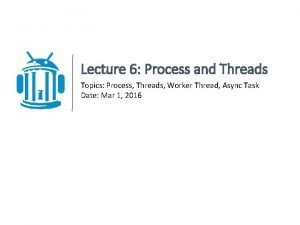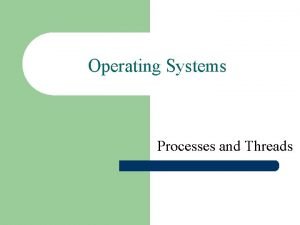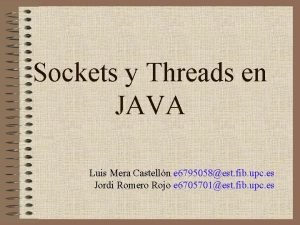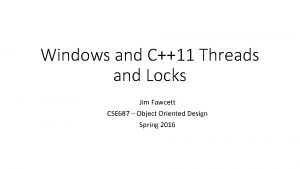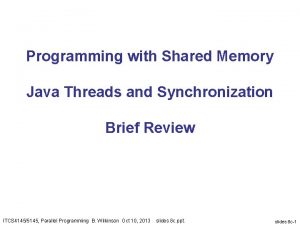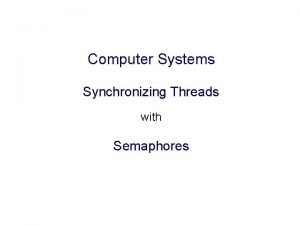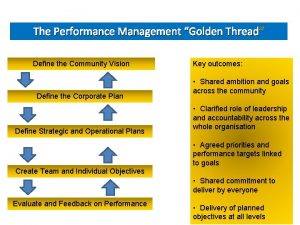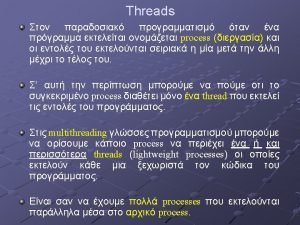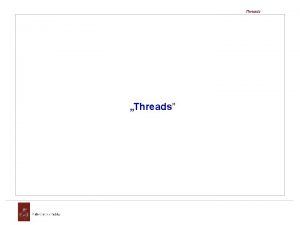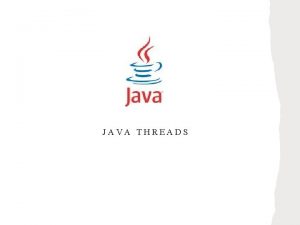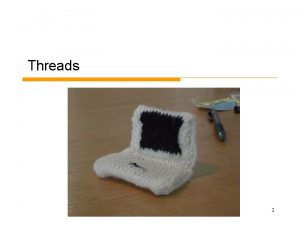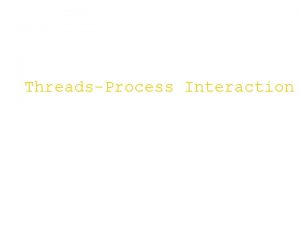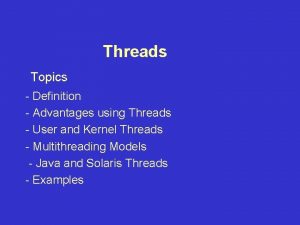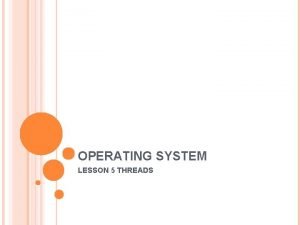Lecture 6 Process and Threads Topics Process Threads














- Slides: 14

Lecture 6: Process and Threads Topics: Process, Threads, Worker Thread, Async Task Date: Mar 1, 2016

References (study these) • http: //developer. android. com/guide/components/processes-and-threads. html

Process • A program is a set of instructions + data stored in an executable image. (passive) • A process is a program “in action” (dynamic) • • • Program counter CPU registers Stacks (parameters, return addresses, saved variables) States – running, waiting, stopped, zombie. Runs in own virtual address space. Uses secure, kernel managed mechanism to interact with other processes. For more info: http: //www. tldp. org/LDP/tlk/kernel/processes. html

Process vs. Thread • Thread = a flow of execution inside a process. • Threads in a process share the same virtual memory address space. • Context switching between threads are faster than context switching between processes. • 1: 1 mapping between kernel space and user space threads.

Android Processes and Threads • Default Behavior: • All components of an App run in the same process and thread (the main/UI thread). • However, you can: • Arrange for components to run in different processes. • Create multiple threads per process. C 1 C 2 C 3 T 1 T P Default C 2 C 1 T 2 P 1 It’s possible P 2

android: process • You can specify android: process in the Android Manifest file for: • <activity>, <service>, <receiver>, <provider> • <application> (all components; same UID and certificate)

Process – creation and removal • Creation: When the first component of an App is run and there is currently no process for that App. • Removal: Remove old processes to reclaim memory for new or more important processes. Which process should be killed?

Process Hierarchy • From High Priority to Low Priority 1. Foreground (highest priority, interactions on-going, can be Activity, Service, Broadcast receiver) 2. Visible (not fore ground but visible) 3. Service (start. Service, playing music/downloads) 4. Background (on. Stop called, no visible, LRU kill) 5. Empty (lowest priority) Kill them first Visible Activity Classified as Visible Process Service P

Main or UI Thread • Created when App is launched • Often called UI thread • Dispatched events to widgets • Your App interacts with components from android. widget android. view package Caution: Don’t run long running (5 sec+) task in the UI thread

Worker Thread • Use these to make UI thread light-weight, responsive. • Limitation: Never access UI toolkit elements (e. g. views) from another thread. Runs in UI Thread Runs in the new worker Thread public void on. Click(View v) { new Thread(new Runnable() { public void run() { Bitmap b = load. Image. From. Network("http: //example. com/i. png" ); m. Image. View. set. Image. Bitmap(b); } }). start(); } Do not try this (i. e. accessing an Image. View which was created in UI thread and now being accessed in a worker thread)

So … two rules to remember • Do not block the UI thread Caution: Don’t run long running (5 sec+) task in the UI thread • Do not access the Android UI toolkit from outside the UI thread.

Access UI Thread from Other Threads • Use one of these three: • Activity. run. On. Ui. Thread(Runnable) • View. post. Delayed(Runnable, long) Runs in UI Thread Runs in worker Thread public void on. Click(View v) { new Thread(new Runnable() { public void run() { final Bitmap bitmap = load. Image. From. Network("http: //example. com/image. png"); m. Image. View. post(new Runnable() { public void run() { m. Image. View. set. Image. Bitmap(bitmap); } }). start(); }

Async Task • Performs the blocking operations in a worker thread, and publishes the results on the UI thread. public void on. Click(View v) { new Download. Image. Task(). execute("http: //example. com/image. png"); } private class Download. Image. Task extends Async. Task<String, Void, Bitmap> { /** The system calls this to perform work in a worker thread and * delivers it the parameters given to Async. Task. execute() */ protected Bitmap do. In. Background(String. . . urls) { Runs in worker return load. Image. From. Network(urls[0]); Thread } /** The system calls this to perform work in the UI thread and delivers * the result from do. In. Background() */ protected void on. Post. Execute(Bitmap result) { Runs in UI m. Image. View. set. Image. Bitmap(result); Thread } } http: //developer. android. com/reference/android/os/Async. Task. html

Thread-safe methods and IPC • Make sure, when multiple threads can invoke a method, the method is thread-safe. Content Provider Query(). Insert(), delete(), update() Another Activity • Android offers inter-process communication using remote procedure calls (RPCs)
 01:640:244 lecture notes - lecture 15: plat, idah, farad
01:640:244 lecture notes - lecture 15: plat, idah, farad Process and threads
Process and threads Process and threads
Process and threads Threads in operating system
Threads in operating system Sockets and threads
Sockets and threads C11 thread
C11 thread Java shared memory between threads
Java shared memory between threads Assembly drawing
Assembly drawing A flexible flat material made by interlacing threads/fibers
A flexible flat material made by interlacing threads/fibers Tipos de escalonamento
Tipos de escalonamento Os threads
Os threads Vinaya pitaka is a sacred text of
Vinaya pitaka is a sacred text of Needle like threads of spongy bone
Needle like threads of spongy bone Helps press seams in tubes like sleeves
Helps press seams in tubes like sleeves Golden thread performance model
Golden thread performance model

